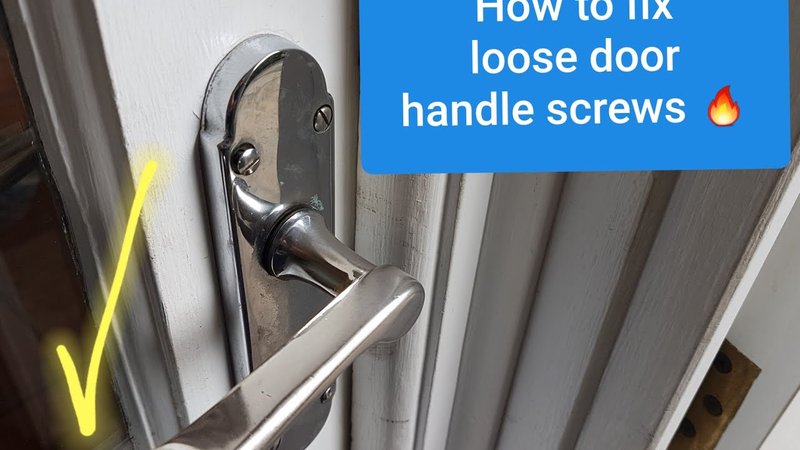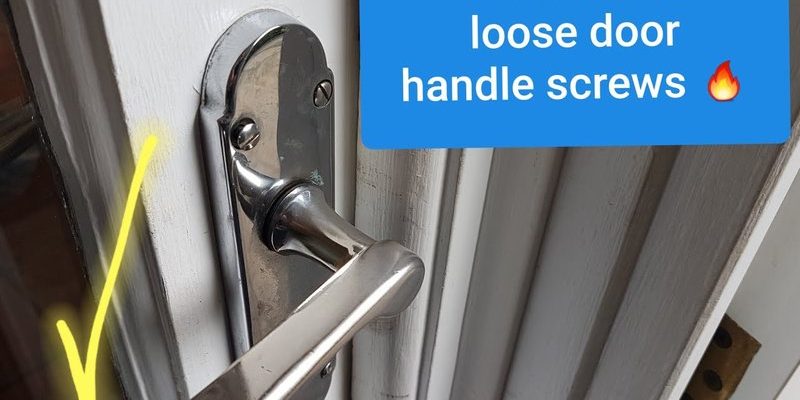
A lot of modern doors, especially fiberglass entry doors, are built hollow to keep them lightweight and affordable. While these doors usually feel sturdy, that hollow core means you’re sometimes dealing with nothing but a thin shell—not the best anchor for handleset screws. If your screws aren’t gripping, it doesn’t matter how many times you try to twist them in or how new your handleset is. The problem won’t go away on its own.
Below, I’ll walk you through the reasons screws don’t grip in hollow fiberglass doors, why it happens, and how to fix it—using simple steps, plain language, and a touch of friendly advice. Whether your door is from Therma-Tru, Masonite, or another big brand, the process is usually the same. So, let’s get those handleset screws holding tight.
Why Handleset Screws Won’t Grip In Hollow Fiberglass Doors
Here’s the thing: Handleset screws are designed to grab onto something sturdy—usually wood. But with a hollow fiberglass door, you’re often left with a thin layer of fiberglass around a foam or empty core. That means there’s little to no solid material for the screws to actually “bite” into. Instead, you get that all-too-familiar feeling where you tighten the screw, but it just spins.
This problem gets even trickier with predrilled holes that are a bit too wide, or when previous hardware has worn out the material around the holes. Sometimes, you’ll find factory “reinforcement blocks” inside the door, but they’re not always placed where you need them. Even with a top-tier handleset from Schlage or Emtek, the quality of the lock doesn’t matter if the door itself can’t hold the screws.
What’s even more frustrating? A loose handleset isn’t just annoying—it can make the door less secure. If the screws aren’t gripping, the whole lock feels wobbly and the handle might pull off if tugged too hard. So, finding a fix isn’t just about convenience; it’s about safety too.
Checking Your Door’s Structure Before Fixing The Screws
Let me explain: Before jumping into repairs, it’s important to know what you’re working with. Hollow fiberglass doors from brands like Therma-Tru or JELD-WEN often have thin skins—usually 1/16″ thick—with foam inside. Occasionally, there are wooden “lock blocks” or reinforced areas where the hardware is supposed to go. Not every door has these blocks, though, especially on older or budget models.
Here’s how you can check:
- Remove the handleset. If it’s a Schlage, Kwikset, or similar, you usually just need to unscrew it from the inside.
- Look at the hole. Do you see wood, hard plastic, or just foam inside?
- Poke gently with a screwdriver. Listen and feel for softness or firmness.
- Shine a flashlight inside. Sometimes you can spot block reinforcements sitting a few inches deep or off-center.
If you see only foam or air, you know there’s no support. But even if there’s a reinforcement block, it’s not always in the right spot for the new handleset. This is a common issue, especially if you’re switching brands—lockset hole placements are rarely universal.
Temporary Fixes: Making Screws Grip In a Pinch
If you’re in a hurry (maybe you’re halfway through a door install and can’t leave it unsecured), there are a few tricks that might work as a stopgap. Are these permanent? Not really. But they can buy you time until you can do a more solid fix.
- Toothpick or matchstick method: Jam a few wooden toothpicks, matches, or even bamboo skewers into the hole around the screw. Add a dab of wood glue if you can. Then drive the screw back in. It works by filling in gaps so the threads can catch onto something. Just keep in mind, this only works if there’s at least a little bit of material for the toothpicks to press against.
- Expanding foam: Spray a little low-expansion foam into the hole, let it harden, and then try inserting the screw. Sometimes the hardened foam gives just enough resistance to hold the screw. It’s better for light-duty situations than securing an entry lock.
- Larger screws: Using a screw that’s slightly longer or wider than the original can sometimes help. Just be careful—the fiberglass can crack if you force in a screw that’s too big.
Honestly, these solutions work best if you’re desperate or dealing with an interior handle instead of a critical exterior lock. For long-term security and safety, you’ll want a real fix.
Permanent Fixes: Creating Solid Anchors For Handleset Screws
If you want your handleset screws to grip like they’re supposed to—and stay that way—there are proven ways to reinforce a hollow fiberglass door. It just takes a little time and the right supplies. Here are some popular, reliable options:
- Install a “door reinforcement plate”: These special metal brackets, sometimes called lock reinforcers or wrap plates, sandwich the door around the handle area. They give the screws a solid, threaded metal anchor instead of relying on just fiberglass. Brands like Prime-Line or Defender Security make plates that fit most door thicknesses.
- Fill the cavity with wood blocks: Cut a piece of hardwood or plywood to fit snugly inside the door where the handleset mounts. You might need to carefully remove some foam insulation with a small saw or chisel. Glue or screw the block into place, then reinstall your hardware. Now, the screws have real wood to grip.
- Use toggle bolts or hollow door anchors: These anchors have wings or expanding sleeves that open up behind the fiberglass skin, holding hardware tightly on thin surfaces. They’re often used for towel bars and curtain rods, but they can be a lifesaver for handlesets too. Just make sure the anchor fits the length of the door, and don’t overtighten.
Each method comes with pros and cons. Plates are the easiest and fastest, but sometimes look a little industrial. Wood blocks make for a hidden, sturdy fix if you’re handy with tools. Anchors are quick but may not be as secure as wood blocks, especially for heavy handlesets or high-traffic doors.
Permanent repairs aren’t just about getting your handleset to work—they’re about reclaiming your peace of mind, knowing your front door is secure and solid.
Step-By-Step: Installing A Wood Block Anchor Inside A Fiberglass Door
If you’re comfortable with basic tools, adding a wood block is the best way to turn a hollow door into a solid one (at least where the screw needs to go). You might be wondering what this actually looks like in real life. Here’s a slow, visual walkthrough:
- Measure the gap inside the door at the handleset location using a tape measure or a stick. Note the door thickness and how much foam you’ll need to remove.
- Cut a wood block from hardwood or high-quality plywood, sized to fit tightly in the cavity (you want no wiggle room). Drill a pilot hole through the center of the block lined up with the screw hole.
- Remove foam using a hole saw, spade bit, or utility knife. Be careful not to cut too much—you want the block to fit snugly just behind the fiberglass skin.
- Slide the block in, making sure the pilot hole stays aligned. For extra strength, run a bead of strong construction adhesive around the block.
- Let the glue cure if you used adhesive. Then, reinstall the handleset and drive the screws into the new wood anchor. They should grip tight, with no spinning or slipping.
Take your time here. The biggest challenge is matching the block location to the hardware holes—measure twice, cut once. With this fix, your Schlage, Kwikset, or generic handleset should feel rock-solid.
Choosing The Right Screws And Anchors For Hollow Fiberglass Doors
Not all screws are created equal. Honestly, using the wrong type is a big reason why handleset screws won’t grip in hollow fiberglass doors in the first place. Let me explain what works (and why):
- Threaded machine screws work best when your handleset passes through the door and bolts into the lock on the opposite side (like most Schlage or Emtek sets). These don’t rely on the door itself for holding power, since they connect handle-to-handle. If possible, upgrade to a set that uses through-bolts.
- Self-tapping wood screws are a decent option if you have a wood block or reinforcement plate. The sharp, deep threads grip wood or metal much better than generic sheet metal screws.
- Hollow-door anchors (like toggle bolts) can save the day for thin, unreinforced areas. The wings open up inside, spreading the load across a bigger area of fiberglass and foam. Just don’t overtighten or you’ll crack the skin.
If you’re unsure what to buy, bring an old screw to the hardware store. Ask for help finding the closest match in length and type—there’s nothing wrong with getting a second opinion, especially if you want your fix to last.
How To Avoid Handleset Screw Problems In The Future
It’s no fun dealing with spinning screws, so let’s talk prevention. Here are some tips that’ll help you avoid this hassle next time around:
- Buy doors with reinforced lock areas whenever possible. Many premium fiberglass doors from Masonite, JELD-WEN, or Therma-Tru have internal wood blocks or metal plates where the handle will go. Ask about this feature before you buy.
- Check fit before installing hardware. If the predrilled holes look wide or soft, add a reinforcement block or plate before mounting the handleset. It’s way easier to do before everything’s installed.
- Use longer through-bolts if your handleset allows. These hold hardware together directly, bypassing the weakness of the door material.
- Don’t overtighten screws. Over-tightening can distort the fiberglass and crush foam, making holes bigger and weaker over time.
- Consider using universal handlesets that are designed for hollow-core or fiberglass doors—they often come with special anchors or plates included.
Taking an extra ten minutes up front can save you hours of frustration (and trips to the hardware store) down the line.
When To Call A Pro Or Replace The Door
Sometimes, even after all the troubleshooting in the world, things just don’t add up. Maybe you’ve tried wood blocks, plates, anchors, and your handleset still won’t stay put. Or perhaps you’ve found out your door is warped, badly damaged, or was never designed for secure hardware in the first place.
At that point, it might be worth calling a locksmith or handyman. They have the tools and experience to fix tricky doors, and can often install proper reinforcements or replace damaged panels without botching the look of your entryway. If you’re dealing with a high-security situation—or just want a door that feels as solid as it looks—sometimes upgrading to a new, reinforced fiberglass door is the best choice for peace of mind.
Don’t feel bad—hollow fiberglass doors can stump even experienced DIYers. It’s better to get help than to risk a loose, insecure front entry.
Wrapping It Up: Getting Handleset Screws To Grip In Hollow Fiberglass Doors
Dealing with handleset screws that won’t grip in a hollow fiberglass door can be a real test of patience, but it isn’t hopeless. The main reason this happens is the lack of solid material inside the door—no matter the brand, type, or style of hardware.
Choosing the right fix depends on your situation and comfort level. Quick tricks (like toothpicks or foam) might do for the short term, but a true repair means adding a solid anchor, like a wood block or reinforcement plate, behind the handleset. Picking the right screws and avoiding overtightening goes a long way, too.
If you’ve ever felt like your door was mocking your DIY spirit, know you’re not alone—and you’re definitely not the only one facing hollow fiberglass challenges. A little know-how, the right parts, and some patient troubleshooting will have your handleset screws gripping (and your front door holding strong) in no time.
